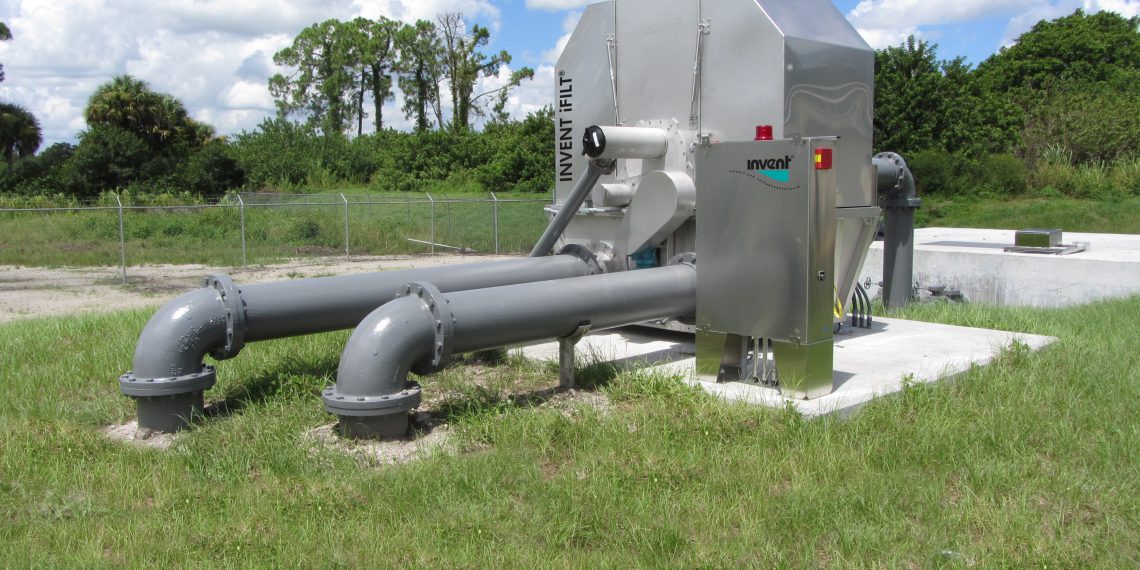The global reuse of water directly after it has been treated in a wastewater treatment plant is increasingly gaining in importance, be it for reasons of environmentalism or efficiency. This increases demands on the treatment of wastewater and requires additional treatment phases. A fundamental part of tertiary wastewater treatment is the added filtration. It is the basis for further steps of conditioning, such as a fourth treatment stage, separation of microplastics, retention of phosphorus, or disinfection.
INVENT Umwelt- und Verfahrenstechnik AG made use of their long-standing experience in the sector of water and wastewater treatment as well as their expertise in the fields of fluid mechanics, hydraulics and component design to develop the iFilt-diamond filter. It was constructed especially for the separation of solids from fluids as the next treatment phase after secondary
sedimentation. It removes the smallest suspended solids that are still present in wastewater, for example activated sludge flakes, microplastics, precipitation flakes after phosphorus reduction or powdered activated carbon. It is extraordinarily energy- and resource-efficient and offers excellent separation performance using a minimum of space.
Industrial enterprises are also greatly interested in the energy-efficient and ecological use of their processing water. The iFilt-diamond filter can be applied in many areas, such as in the general reuse of processing water in the paper and textile industries, water treatment in fisheries or the treatment of flush water in the beverage industry.
Enhanced hydraulic performance due to cross-flow-filtration
The iFilt-diamond filter uses a well-thought-out fluid-mechanical overall concept. Depending on the individual case this concept enhances hydraulic performance by up to 100 percent! This is achieved by using a holistic fluid-mechanical optimization approach that is based on the principle of cross-flow-filtration.
The continuous rotation of the disc, the very high rotational speed and the thus initiated effect of a tangential-dynamic filtration limit the built-up of a surface layer to a minimum and enable an optimal hydraulic discharge. A small number of rotating filter discs already achieve high throughputs. This means low spatial requirements: the iFilt-diamond filter can be put into operation even under restricted circumstances with regard to space.
Many advantages for the operating company
Apart from the hydraulic efficiency and the resulting high economic efficiency the iFilt-diamond filter offers additional advantages for the operator. The fact that no large-scale gasket neither in the rotor’s feed nor the discharge area is required makes the machine virtually maintenance-free. Leakage and therefore unnoticed deterioration of the filtrate’s quality will not happen. As the filter disc is in constant rotation the energy-intensive backwashing cycles are reduced to a minimum and the overall energy consumption of the filter is extremely low.
All components of the iFilt-diamond filter are made of high-quality stainless steel, therefore by far exceeding all requirements of modern wastewater treatment with regard to durability and longevity. The applied material meets the highest demands on robustness and mechanical stability even under the most adverse conditions.
Conclusion on iFilt-diamond filter
Up to now the processing steps of filtration or micro-sieving have been connected with high investment costs, a fact that has a deterring effect on many municipalities and industrial enterprises. However, public pressure to tackle this subject in order to protect the environment is mounting. The newly developed and fluid-mechanically optimized iFilt-diamond filter meets all
demands on continuative treatment steps in communal and industrial water treatment. Invent therefore makes sure that tertiary treatment steps can be realized in a more economic and largescale way.
Invent at the Ifat: hall A2, stand 327/426

















